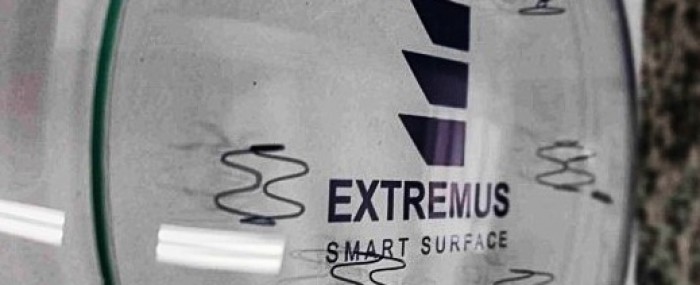

Treatment with biomaterials developed by Extremus induces changes in the microscopic structural configuration of the implant surface, optimizing its fixation to the bone and reducing the chances of failure (image: Extremus)
Technology created by a startup supported by FAPESP accelerates patient recovery and improves biological integration.
Technology created by a startup supported by FAPESP accelerates patient recovery and improves biological integration.

Treatment with biomaterials developed by Extremus induces changes in the microscopic structural configuration of the implant surface, optimizing its fixation to the bone and reducing the chances of failure (image: Extremus)
By Roseli Andrion | Agência FAPESP – The number is disturbing. A study conducted by the general and teaching hospital ("Hospital das Clínicas") of the Ribeirão Preto Medical School of the University of São Paulo (HCFMRP-USP) in Brazil followed 99 patients who underwent hip and knee replacement surgery in 2020. The study revealed that 32.3% of the patients experienced complications within 30 days of discharge, with 12.1% experiencing local infections. A similar concern arises in dentistry. In 2022, a study by the Federal University of Santa Catarina (UFSC) in Brazil evaluated 85 dental implants in 37 patients and found a failure rate of 7.1%.
For those undergoing these procedures, these percentages translate into pain, additional costs, and months of waiting before they can resume their routine. In response to this issue, Extremus Smart Surfaces, a startup supported by FAPESP's Innovative Research in Small Businesses Program (PIPE), developed a solution that can accelerate the process: surfaces that interact with human cells and guide them toward faster and more efficient regeneration.
Microscopic technology transforms common medical implants into smart biomaterials that can reduce recovery time and failure rates. "We optimize the biological integration between the material and the organism through surface treatment," explains Diego Pedreira de Oliveira, founder of the company. "Although invisible to the patient and doctor, this significantly accelerates healing."
Specific nanotopography
While common implants have a smooth and uniform surface in one segment or a randomly rough surface in another, Extremus's technology uses specific nanotopography, a microscopic structural configuration that interacts closely with cells. According to Oliveira, international scientific literature confirms that changes in surface topography can positively influence implant integration. In practice, the implant attaches better to the bone, reducing the chances of failure.
Results from preclinical animal testing indicate significant improvements in fixation. "In addition, we conducted studies with human bone marrow stem cells," says Oliveira. "They have the potential to differentiate into various cell lines. When we put them in contact with our specific surface for bone production, the multipotent cell transforms into an osteoblast, which forms new bone."
Extremus's innovation comes at a pivotal time for the sector. The global dental implant market was valued at US$4.6 billion in 2023 and is projected to grow by 6.1% annually until 2030, according to Grand View Research. Additionally, the Brazilian medical device sector generated over R$12 billion in 2023, according to the Brazilian Medical Devices Manufacturers Association (ABIMO).
Beyond dentistry
The company operates in three main segments: dental, orthopedic (for femurs, knees, elbows, etc.), and cardiovascular. "The most interesting thing is that in the most critical segment of implants, cardiovascular, we had the best reception," the researcher reveals. For this sector, the technology represents an even more significant evolution because the devices must properly interact with the circulatory system; any failure could have serious consequences.
In Brazil, at least 800,000 dental implants are performed each year, according to ABIMED. Although the success rate of implants is high, improving biological integration represents a significant advance in patient well-being. The technology is already patented.
As with all innovations in the medical field, the startup's solution must undergo rigorous regulatory processes. The company licenses its technology to established manufacturers and does not manufacture its own implants. "Our product isn't isolated," Oliveira explains. "It transforms the surface of partner manufacturers' products."
Thus, the manufacturers register each specific application with the Brazilian Health Regulatory Agency (ANVISA). "Once we have registered various products, ANVISA is likely to understand that the solution is effective and safe," the researcher predicts. Currently, the startup is focused on developing products for the cardiovascular segment, which has high impact potential.
Future prospects
The technology is more than just an incremental improvement; it represents a paradigm shift in the design of medical implants. "Currently, implants are often viewed solely as mechanical fixations," he says. "It's like when you put a screw in a wall. We worry about whether it's tightened, but not what happens next."
The startup's proposal is to transform this understanding. With an aging population, an increasing demand for implants, and a fast-paced lifestyle that requires quicker recovery times, Extremus's approach could transform the future of regenerative medicine. "Accelerated healing gets patients out of the postoperative period more quickly," he summarizes.
The company plans to expand internationally – and the startup's name was chosen strategically. “We chose an English name because we considered internationalization from the beginning,” Oliveira reveals. He believes that international projection could strengthen the company's position in the Brazilian market. "If we have projection abroad, we gain more notoriety here."
Republish
The Agency FAPESP licenses news via Creative Commons (CC-BY-NC-ND) so that they can be republished free of charge and in a simple way by other digital or printed vehicles. Agência FAPESP must be credited as the source of the content being republished and the name of the reporter (if any) must be attributed. Using the HMTL button below allows compliance with these rules, detailed in Digital Republishing Policy FAPESP.





